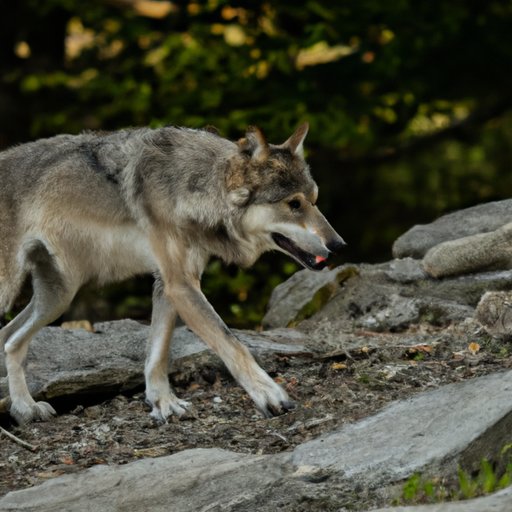Introduction
A wolf pack is a group of wild wolves that live and hunt together. The pack is essential to the survival of the species and helps each individual wolf to thrive. Wolves have been observed travelling in packs since ancient times, displaying remarkable teamwork and coordination. In this article, we will explore how a wolf pack travels, including its anatomy, strategies, benefits, and challenges.

Anatomy of a Wolf Pack
The structure of a wolf pack is divided into two parts: the breeding pair (the alpha wolves) and their offspring. The alpha wolves are typically the largest and strongest members of the pack, and they lead the pack when it comes to hunting, decision making, and travel. The other members of the pack are generally their children and siblings, although sometimes unrelated wolves may join the pack.
When traveling, the wolves form a single line with the alpha wolves at the front. This allows them to keep track of one another and stay together. The alpha wolves will also use their body language to direct the movements of the rest of the pack. For example, they may signal when to stop or change direction.

Strategies Used by Wolf Packs
Wolves use several strategies when traveling in a pack. One of the most important is scent marking. By urinating and defecating in certain areas, the alpha wolves mark their territory and let other wolves know that they have been there. This helps the pack to stay together and avoid getting lost.
Communication is also essential during travel. Wolves communicate with one another through vocalizations such as growls, whines, and barks. They also use body language such as tail wagging and facial expressions to indicate their intentions and feelings. This helps the pack to stay organized and move together in the same direction.
Finally, the alpha wolves play an important role in leading the pack. They set the pace for the pack and make decisions about which direction to take. They also decide when to stop and rest, as well as when to start hunting.
Benefits of Traveling in a Pack
Traveling in a pack has many advantages. Firstly, it allows the wolves to cover more ground and find food faster than if they were to travel alone. Secondly, the pack provides protection from predators. By staying together, the pack can fend off larger predators or drive away smaller ones. Finally, traveling in a pack makes it easier for the wolves to find mates and reproduce.
Traveling in a pack also allows wolves to share resources. If one wolf finds food, the others can benefit from it too. This is especially important for young pups who are not yet able to hunt on their own. Traveling in a pack also allows the wolves to conserve energy, as they take turns leading the pack and taking breaks along the way.

Challenges Faced by Wolf Packs
Although traveling in a pack has many advantages, it also presents some unique challenges. Wolves must constantly be aware of their surroundings, as different terrains can present obstacles. Additionally, wolves must be careful when encountering other predators or prey, as the pack may need to defend itself or flee quickly. Finally, the pack must be vigilant in order to avoid humans, who may pose a threat to their safety.
Conclusion
In conclusion, wolves travel in packs for a variety of reasons. Their structure, strategies, benefits, and challenges all play an important role in the success of their journeys. Wolves use scent marking and communication to stay together and navigate their way through different terrains. Additionally, traveling in a pack offers protection and the ability to share resources. Finally, wolves must be aware of the unique challenges that come with traveling in a pack, such as avoiding predators and humans. By understanding these aspects of wolf travel, we can gain insight into their behavior and appreciate the remarkable teamwork and coordination that goes into every journey.
Now that you understand how a wolf pack travels, you can appreciate their incredible strength and resilience. Whether you’re watching them in the wild or admiring them from afar, you’ll now be able to recognize the impressive tactics they use to survive and thrive.
(Note: Is this article not meeting your expectations? Do you have knowledge or insights to share? Unlock new opportunities and expand your reach by joining our authors team. Click Registration to join us and share your expertise with our readers.)
